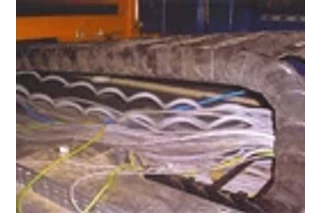Change Language :


It's very important for cables used in continuous-flex applications to follow certain construction and performance guidelines.
However, before choosing a continuous-flex cable for your application, it's helpful to understand the main reasons why cables fail.
Here are six symptoms of cable failure design engineers should watch out for:
1. Loss of continuity: Copper conductors can sever and break, causing loss of continuity, when insulated conductors are twisted with an incorrect pitch length or pitch direction. The cable core cannot absorb the mechanical load while flexing so it transfers the force to the copper conductors, which causes them to break under the increased tensile load.
2. Isulation damage: Insulation damage occurs when the insulation integrity of the conductors is compromised. This is caused by material fatigue under constant bending stress, abrasion within the cable structure, and / or conductor strand breakage. All of which can perforate the insulation.

3. Corkscrew: This failure is easily recognized by the mechanical deformation of the entire cable (Figure 2). The corkscrew or "pigtail" effect occurs when torsional forces are released during operation due to incorrect cable configuration, pitch length and pitch direction. Cables that are constructed in layers rather than bundled are more susceptible.
4. Jacket abrasion: Jacket abrasion occurs when the outer jacket of a cable wears through to the underlying layer of conductors or shielding. This failure is especially common when using cables with soft jackets. However, this problem can also be caused by a thin wall-thickness that can develop during the jacket extrusion process.
5. Jacket swelling / cracking: The outer jacket of a cable swells when it has been exposed to oils or chemicals it was not designed to withstand. Jacket cracking occurs when the jacket breaks and deteriorates down to the cable's shield, normally as a result of excessively high or low temperatures (Figure 1).
6. Shielding losses / EMC problems: Increased electromagnetic interference (EMI) occurs when the shield, which is designed to protect cable signals from electromagnetic fields, breaks and abrasions due to continuous bending.
Recognizing these failure modes is essential in order to minimize unexpected production downtime. Understanding them at the beginning of the buying process also increases the likelihood that you will specify the optimal cable for your automated application and save time and money later.
Useful Links